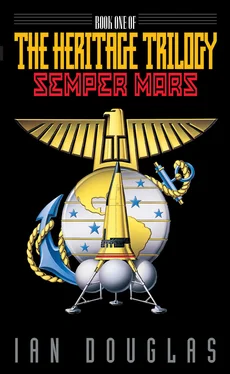All of which meant that Mars Mean Time, or MMT, had nothing whatsoever in common with GMT. It was now, he saw, 1740 hours at Cydonia—late afternoon—and 2126 hours in Greenwich. Of course, for the next fifteen months or so, his only interest in what time…or day…it was on Earth would be when he had to calculate the arrival or departure time of another report.
“So,” Fulbert said, still clinging to the conversation thread, “you don’t think aliens did stuff on Earth? You know, the pyramids? Easter Island? All that shit?”
He decided not to mention his own reservations about the Giza pyramids, at least. “Easter Island? Certainly not! We know how the local population built and raised those great stone heads, because they showed us. No mystery there at all.”
Turning away in another attempt to end the conversation, he pressed his face against the tiny port. He could see sky above—still a dark, purplish color at the horizon turning to jet-black overhead. Below, the Martian surface spread out beneath a curved horizon, a dusty, dusky ocher color tinted with streaks of rust and gray-brown. They were still too high up for the smaller details of the surface to be visible, but he could see scattered, shadow-edged shapes that must be mountains or the jumble of chaotic terrain. He tried to orient himself. If it was late afternoon here, then north would be that way…but he didn’t know if they were even descending in an attitude that would let him see the Face or the attendant structures. It was frustratingly like trying to recognize buildings or landmarks from the air while approaching a city’s airport on Earth. For all he knew, the Cydonian ruins were on the other side of the—
He saw it.
My God! It’s just like they all said…but so…so unexpected….
It was smaller than he’d thought it would be, which was why he’d overlooked it at first. Bizarre must still be twenty or thirty kilometers up. He looked down on the Cydonian Face, and it returned his wondering stare with the same enigmatic and Sphinx-like skyward gaze it had worn for half a million years.
First captured by chance on two frames shot by the Viking 1 orbiter spacecraft in 1976, the Face hadn’t even been noticed until the early 1980s…and then the image had been dismissed as a trick of the light and of the remarkable persistence of the human mind in imposing order and facial features on random shapes, be they ink-blots on a paper, or a mile-long landform in the desert. By the turn of the century, space probes had returned better images, and NASA had—with some reluctance—acknowledged at last that there might be something there worth investigating after all. That revelation, that intelligence had carved a mile-long face into a mesa in the Cydonian region of Mars, was the last in a rapid-fire barrage of discoveries that had completed at last the long-fought Copernican Revolution. Since the 1990s, it had been known that planet-bearing stars were common, and evidence of fossilized bacteria had been discovered on a meteorite gouged from the Martian surface eons before.
Humankind was not alone in the universe.
Those discoveries had spurred a long-awaited renaissance in space exploration. The first manned landing on Mars, a joint US-Russian venture, had taken place in 2019 at Candor Chasma; it wasn’t until the second landing five years later that Geoffrey Cox, Anatol Kryukov, and Roberta Anders had stood at last in the shadow of that alien-carved enigma and wondered….
Конец ознакомительного фрагмента.
Текст предоставлен ООО «ЛитРес».
Прочитайте эту книгу целиком, купив полную легальную версию на ЛитРес.
Безопасно оплатить книгу можно банковской картой Visa, MasterCard, Maestro, со счета мобильного телефона, с платежного терминала, в салоне МТС или Связной, через PayPal, WebMoney, Яндекс.Деньги, QIWI Кошелек, бонусными картами или другим удобным Вам способом.












